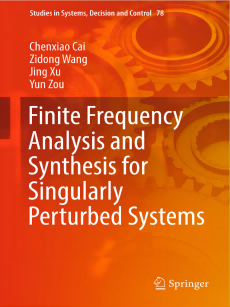内容简介:
The series “Studies in Systems, Decision and Control”(SSDC) covers both new developments and advances, as well as the state of the art, in the various areas of broadly perceived systems, decision making and control- quickly, up to date and with a high quality. The intent is to cover the theory, applications, and perspectives on the state of the art and future developments relevant to systems,decision making, control, complex processes and related areas, as embedded in the fields of engineering, computer science, physics, economics, social and life sciences, as well as the paradigms and methodologies behind them. The series contains monographs, textbooks,lecture notes and edited volumes in systems,decision making and control spanning the areas of Cyber-Physical Systems,Autonomous Systems, Sensor Networks, Control Systems,Energy Systems,Automotive Systems,Bio-logical Systems,Vehicular Networking and Connected Vehicles,Aerospace Systems,Automation,Manufacturing,Smart Grids,Nonlinear Systems, Power Systems,Robotics,Social Systems,Economic Systems and other. Of particular value to both the contributors and the readership are the short publication time frame and the world-wide distribution and exposure which enable both a wide and rapid dissemination of research output.
英文目录:
Part I Preliminaries
1 Singular Perturbation Methods and Time-Scale Techniques
1.1 Modelling
1.1.1 Singularly Perturbed Phenomena
1.1.2 Linear Time-Invariant Singularly Perturbed Systems
1.1.3 Nonlinear Singularly Perturbed Systems
1.1.4 Hybrid Singularly Perturbed Systems
1.2 Time -Scale and Frequency -Scale Analysis
1.2.1 Time-Scale and Multiple Time-Scales
1.2.2 Multiple Frequency -Scales
1.3 Slow-Fast Decomposition Method
1.3.1 Decoupling Transformation
1.3.2 Construction of Slow and Fast Subsystems
1.4 Controllability and Observability
1.5 Conclusion
References
2 Theoretical Foundation of Finite Frequency Control
2.1 The Laplace Transform
2.2 Frequency Division Strategies
2.2.1 Weighting Functions
2.2.2 General Kalman-Yakubovich-Popov Lemma
2.3 Characterization of Control Performance Index
2.3.1 Characterization of Finite Frequency Ranges
2.3.2 Window Norm
2.3.3 Frequency Domain Inequalities
2.4 Conclusion
References
Part II Singularly Perturbed Systems Analysis and Synthesis
3 Stabilization of Singularly Perturbed Systems
3.1 Stability Analysis of Dynamical Systems
3.2 Stability Analysis and Integration
3.3 Stability Theory on Time Domain
3.3.1 Method Based on Slow and Fast Subsystems
3.3.2 A Descriptor-System Method
3.4 Stability Theory on Frequency Domain
3.5 Conclusion
References
4 Finite Frequency H∞ Control for Singularly Perturbed Systems
4.1 Background Information for H∞ Control of Singularly Perturbed Systems
4.2 Finite Frequency H∞ State Feedback Control
4.3 Finite Frequency H∞ Output Feedback Control
4.3.1 The Slow Subsystem and Associated H∞ Controller in the Low-Frequency Domain
4.3.2 The Fast Subsystem and Associated Controller in the High-Frequency Domain
4.4 A Descriptor-System Approach for H∞ Control of Singularly Perturbed Systems
4.4.1 Shaping the High-Frequency Characteristics of a Singularly Perturbed Systems
4.4.2 Shaping the Low-frequency Characteristics of a Singularly Perturbed Systems
4.5 Finite Frequency H∞ Tracking Problem
4.6 Finite Frequency H∞ Model Matching Problem
4.7 Conclusion
References
5 Finite Frequency Positive Real Control for Singularly Perturbed Systems
5.1 Passivity and Positive Real Property
5.2 Methods Based on Slow-Fast Decomposition
5.2.1 State Feedback Control for General Linear Systems
5.2.2 Finite Frequency Positive Real Control for Singularly Perturbed Systems
5.3 A Descriptor-System Method for Strictly Positive Real Control of Singularly Perturbed Systems
5.4 Conclusion
References
6 The Sensitivity-Shaping Problem for Singularly Perturbed Systems
6.1 Sensitivity Function and Complementary Sensitivity Function
6.2 Finite Frequency S/ T Mixed Sensitivity Design for SISO Singularly Perturbed Systems
6.3 Finite Frequency H_/H∞ Control for MIMO Singularly Perturbed Systems
6.4 Fault Detection for Singularly Perturbed Systems
6.4.1 Internal Stability Conditions
6.4.2 Disturbance Attenuation Conditions
6.4.3 Fault Sensitivity Conditions
6.5 Conclusion
References
Part III Applications
7 Applications
7.1 Background of Applications of Singular Perturbation Methods
7.1.1 Applications of Singular Perturbation Methods in Aerospace
7.1.2 Applications of Singular Perturbation Methods in Mechanical Systems
7.1.3 Applications of Singularly Perturbed Methods in Electrical and Electronic
Circuits Systems
7.1.4 Applications of Singular Perturbation Methods in Chemical Reactions and Reactors
7.1.5 Applications of Singular Perturbation Methods in Biology
7.1.6 Applications of Singular Perturbation Methods in Other Areas
7.2 Wind Turbines Control Using Linear Parameter Varying Singularly Perturbed Model
7.2.1 Stability Analysis of Open-Loop System
7.2.2 Controller Design
7.2.3 Algorithm of Synthesis
7.2.4 Simulation Examples
7.3 Robust H∞ Controller for Miniature Quad-Rotors in Hovering
7.3.1 Modelling
7.3.2 Design of H∞ Controller for Miniature UAVs in Hovering
7.3.3 The Flexible Strategy
7.3.4 Numerical Examples
7.4 Conclusion
References
Index

